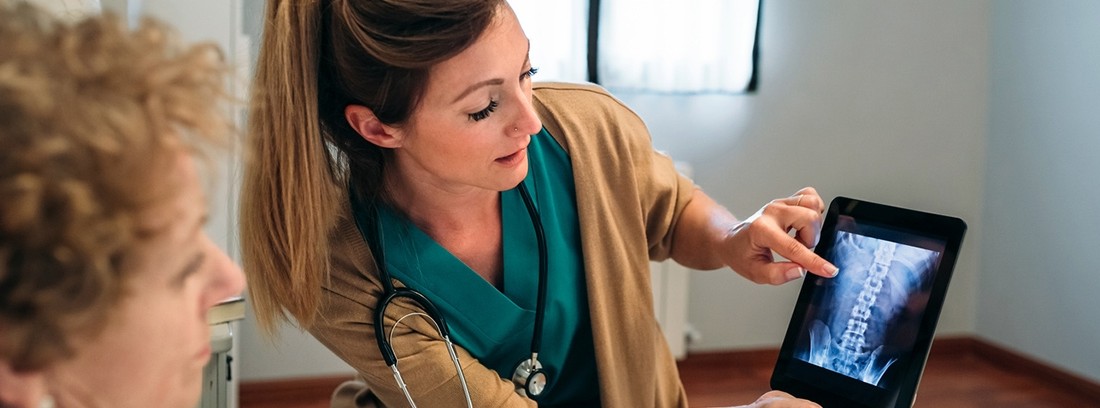Densitometry

Inside the bone, numerous metabolic changes take place, alternating phases of destruction and formation. These phases are regulated by different hormones, physical activity, diet, toxic habits and vitamin D, among other factors.
Osteoporosis
It is a disease characterized by a progressive loss of calcium and a decrease in bone mass. Bones become more brittle and thinner, increasing the risk of fractures. Although plain radiographs are a good method for diagnosing fractures, they are not an indicated examination for evaluating bone mass. For a proper diagnosis of osteoporosis, densitometry is used.
Bone densitometry
It is a quick and comfortable test that allows determining mineral density or bone mass. The apparatus consists of a radiation-emitting part and a receiving part. It uses ionizing radiation for its operation, generating two beams of X-rays. One of the beams is absorbed by the soft parts of the body and the other by the bone. The radiation absorbed by the patient is extremely small, less than one-tenth the dose of a chest X-ray.
The equipment detects the amount of radiation absorbed from each of the beams when passing through the patient and with that information and through a computer program calculates the bone mineral density of the bone scanned. The result obtained is compared with an average value of individuals of the same age and sex, and this makes it possible to determine the risk of fractures and the state of osteoporosis of the patient.
The study of densitometries over a period of time can also document the evolution of calcium loss and make it possible to develop a prognosis, establish the corresponding preventive treatments and assess the response to them.
exist central and peripheral densitometry. In central densitometry, measurements are usually made in the lumbar spine and hips. Peripheral densitometry is usually performed with portable devices, useful for screening for osteoporosis, and bone density is studied in the wrists, fingers, or the calcaneus.
How is the study done?
The examination is performed in radiology or nuclear medicine services. Densitometry equipment consists of a flat table on which the patient lies and an arm suspended over the head that moves during the examination. Usually you have to undress and put on a gown.
Then you have to stand on the team table. Once on the table, you must remain motionless for the test to be carried out properly. The mobile arm of the device will start the examination. The detector slowly travels through the areas to be explored, generating information that will be subsequently analyzed. The areas usually explored are the hip and the lumbar spine, two anatomical regions in which osteoporotic fracture is frequent.
When examining the lumbar spine, a pillow is usually placed under the legs to flex the hips and have the spine correctly positioned for the examination. If the hip is explored, the legs are placed in internal rotation.
Preparation for the study
It is not necessary to be fasting for the test, but if calcium supplements are taken they must be stopped 24 hours before. It is advisable to wear comfortable clothes. The patient should inform their physician if they have recently had a barium scan or CT scan or isotopic study with contrast injection. In this case, you would have to wait 10 to 14 days for the test.
What does it feel like during and after?
The study is completely painless. It can last between 10 and 30 minutes depending on the equipment used and the parts of the body scanned. After the examination, the patient can return to his usual life.
Risks and contraindications
It is a simple and non-invasive procedure. It is painless and the exposure to ionizing radiation is minimal, less than that of a chest X-ray, so it does not involve health risks. There are no foreseeable complications with the procedure described. In the case of exposure of the fetus in pregnant women, it can lead to malformations, especially in the first trimester of pregnancy.
The pregnant woman or who suspects that she may be pregnant should avoid the study and should tell her doctor that she is pregnant before undergoing a densitometry.
Reasons why the study is carried outDensitometry makes it possible to assess the risk of developing a fracture and is used mainly in the diagnosis of osteoporosis, a condition that more frequently affects women after menopause, but which can also occur in men. If bone density is low, treatment is established to prevent fractures. It also makes it possible to assess the effects of treatment or other conditions that cause bone loss.
The densitometric study is especially indicated in those patients in whom there are various risk factors for the development of osteoporosis. Among the most important risk factors are:
(Updated at Apr 14 / 2024)